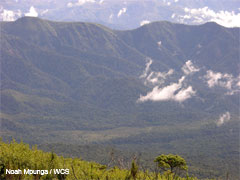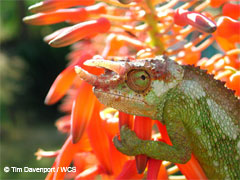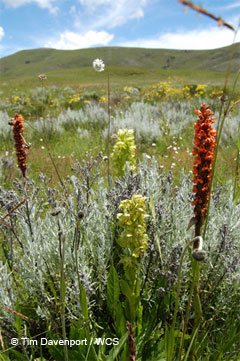The WCS Southern Highlands Conservation Program
The Southern Highlands Conservation Program (SHCP) was started by WCS in 2000 to conserve important upland habitats and species across southwest Tanzania. The Highlands lie between Lakes Nyasa/Malawi and Tanganyika on the junction of the eastern and western arms of the Great Rift Valley. Sites of particular interest are plateau grasslands, montane forests and crater lakes including Kitulo Plateau, Mt Rungwe, Livingstone Mts, Mbisi, Mporoto and Mbeya Range.  The Livingstone escarpment within Kitulo National Park viewed from the summit of Mt Rungwe. Photo: Noah Mpunga / WCS The Livingstone escarpment within Kitulo National Park viewed from the summit of Mt Rungwe. Photo: Noah Mpunga / WCS  The Poroto Three-horned Chameleon (Chamaeleo fuelleborni) is one of the rarest chameleons on the continent, globally restricted to just four sites in Tanzania's Southern Highlands. Reaching a length of 22 cm, the males of this arboreal species are highly territorial, using their horns to fight for females. They give birth to as many as 15 live young (Photo (c) Tim Davenport / WCS) The Poroto Three-horned Chameleon (Chamaeleo fuelleborni) is one of the rarest chameleons on the continent, globally restricted to just four sites in Tanzania's Southern Highlands. Reaching a length of 22 cm, the males of this arboreal species are highly territorial, using their horns to fight for females. They give birth to as many as 15 live young (Photo (c) Tim Davenport / WCS)  Bustani ya Mungu - God's garden. Satyrium and Habenaria orchids on Kitulo Plateau. Photo: Tim Davenport / WCS Bustani ya Mungu - God's garden. Satyrium and Habenaria orchids on Kitulo Plateau. Photo: Tim Davenport / WCS | |
The WCS Southern Rift Program
The Southern Rift Program is a new regional initiative building on current WCS projects including the Southern Highlands Conservation Program (SHCP) in Tanzania and the Mt Mulanje Biodiversity & Monitoring Project in southern Malawi. Conservation work in the Mozambique Mts and the Nyika National Park in northern Malawi are being planned. Regarded biologically as ‘globally outstanding’, the Southern (or Nyasa) Rift begins at the junction of the Eastern and Western (Albertine) Rifts in southwest Tanzania. It extends southward through Malawi and central Mozambique.Through the management of these projects and the development of additional ones, the Southern Rift Program aims to assist in the conservation of important habitats and species across the region.
http://news.mongabay.com/2005/0519-new_monkey.html

No comments:
Post a Comment